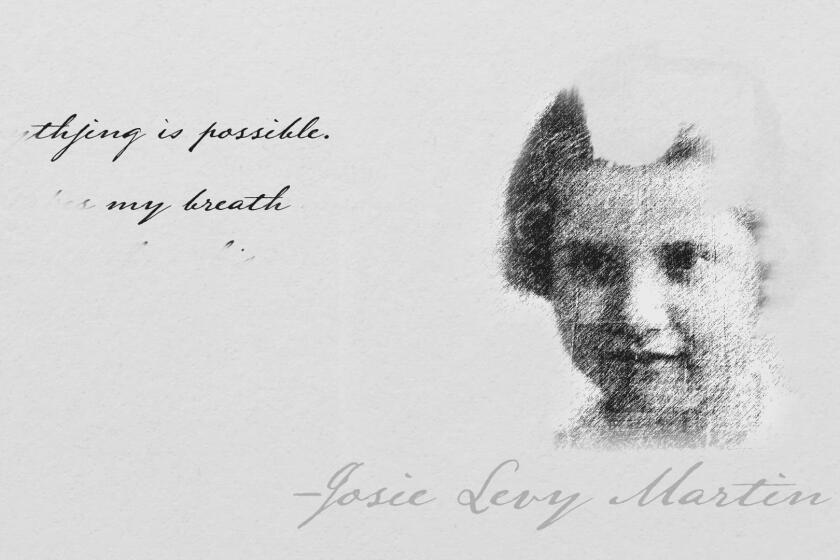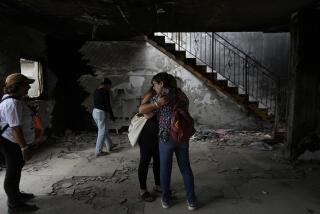Auschwitz was liberated 80 years ago. The spotlight is on survivors as their numbers dwindle

- Share via
WARSAW — The world’s focus will be on the remaining survivors of Nazi Germany’s atrocities on Monday as world leaders and royalty join them for commemorations of the 80th anniversary of the liberation of Auschwitz.
The main observances take place at the site in southern Poland where Nazi Germany murdered more than a million people, most of them Jews, but also Poles, Roma and Sinti, Soviet prisoners of war, LGBTQ people and others targeted for elimination in Adolf Hitler’s racial ideology.
The anniversary has taken on added poignancy because of the survivors’ advanced age, and an awareness that they will soon be gone, even as new wars make their warnings as relevant as ever.
The Auschwitz-Birkenau State Museum says it expects about 50 survivors of Auschwitz and other camps to attend the events on Monday afternoon, joined by political leaders and royalty.
On this occasion, the powerful will sit and listen to the voices of the former prisoners, while there is still time to hear them.
Auschwitz the labor and death camp
The German authorities founded the Auschwitz concentration camp in 1940 in the Polish town of Oswiecim after their invasion of Poland in 1939. Early on it was a camp for Polish prisoners, including Catholic priests and members of the Polish underground resistance. The Germans later established some 40 camps in the area, but the most infamous is Birkenau, a vast site that was part of the Auschwitz complex, used for mass killings in gas chambers.
After 80 years, not many Auschwitz survivors are left. One man makes telling the stories his mission
A Holocaust survivor who lived through four concentration camps will return to Auschwitz to mark 80 years since liberation of the notorious Nazi camp.
Those arriving at Birkenau were brought in cramped, windowless cattle trains. At the infamous ramp, the Nazis selected those they could use as forced laborers. The others — the elderly, women, children and babies — were gassed to death soon after their arrival.
Altogether the Germans murdered 6 million Jews, or two-thirds of all of Europe’s Jews, in the Holocaust at Auschwitz and other camps, in ghettos and in mass executions close to people’s homes.
Liberated by the Red Army
On Jan. 27, 1945, Soviet troops arrived at the gates of Auschwitz and found some 7,000 weak and emaciated prisoners.
Boris Polevoy, a correspondent for the Soviet newspaper Pravda who was a first eyewitness, described a scene of unbelievable suffering: “I saw thousands of tortured people whom the Red Army had saved — people so thin that they swayed like branches in the wind, people whose ages one could not possibly guess.”
At the time Allied troops were moving across Europe in a series of offensives against Germany. Soviet troops first liberated the Majdanek camp near Lublin in July 1944, and would go on to liberate Auschwitz, Stutthof and others.
American and British forces liberated camps to the west, including Buchenwald, Dachau, Mauthausen and Bergen-Belsen.
After liberation day, some prisoners died of disease. Many confronted the grief of murdered parents and children, spouses and siblings. Entire families were wiped out.
“For Jewish survivors, the liberation day is a very, very sad day,” Havi Dreifuss, a historian of the Holocaust at Tel Aviv University said in a recent online discussion about the anniversary.
Auschwitz the memorial site
Today the site is a museum and memorial managed by the Polish state and is one of the most visited sites in Poland. Its mission is to preserve the objects there and the memory of what happened there; it organizes guided tours and its historians carry out research. In 2024, more than 1.83 million people visited.
The museum’s challenges are huge, and include efforts to conserve barracks and other objects that were never intended to endure for long. One especially emotional project involves the conservation of shoes of slain children.
Auschwitz as a symbol for all the Nazi terror
Auschwitz is not only the place where 1.1 million people, 90% of them Jews, were massacred. It also looms large in the world’s collective memory as the embodiment of all the Nazis crimes, and an example of what hatred, bigotry, racism and antisemitism can lead to.
One reason that Auschwitz has emerged as the leading symbol of the Holocaust and other Nazi crimes is that it was also a labor camp, and thousands survived, eyewitnesses who could tell the world what happened there.
“Relatively many people survived, which, for example, barely happened in sites which didn’t have such a forced labor component,” said Thomas Van de Putte, a scholar who specialized in cultural and collective Holocaust memory at King’s College London.
Up to 900,000 people, mostly Jews, were murdered in Treblinka from 1942-43, and mass killings also took place at Belzec and other camps, but the Germans sought to cover up the evidence of their crimes, and there were almost no survivors.
At Auschwitz, the Germans left behind barracks and watchtowers, the remains of gas chambers and the hair and personal belongings of people killed there. The “Arbeit Macht Frei” gate is recognized the world over.
At Birkenau, what remains has also left its mark on the collective conscience. As Van der Putte notes: “You have the gate, you have the wagon. You have the incredibly long railway platform which leads to the former crematoria and gas chambers.”
Who is going
Presidents, royalty, ambassadors, rabbis and priests will be joining the survivors in a heated tent set up at Birkenau on Monday afternoon.
Germany, a country that for decades has been expressing remorse for the nation’s crimes under Adolf Hitler, will be represented by Chancellor Olaf Scholz and President Frank-Walter Steinmeier. Also attending will be the president of Austria, which was annexed by Hitler in 1938, and Italy, whose dictator Benito Mussolini formed an alliance with Hitler.
Others attending include Polish President Andrzej Duda, Canadian Prime Minister Justin Trudeau and French President Emmanuel Macron.
Britain’s King Charles III, who has long worked to promote Holocaust remembrance, will also attend along with other European royalty, including Spain’s King Felipe VI.
Who won’t be there
Russian President Vladimir Putin was an honored guest at the 60th anniversary in 2005, a testament to the Soviet role in liberating Auschwitz and the heavy price paid by Soviet troops in defeating Germany.
But he is not welcome anymore due to Russian war in Ukraine. It will be the third year in a row — following Russia’s full-scale invasion of Ukraine in February 2022 — with no Russia representative.
“This is the anniversary of liberation. We remember the victims, but we also celebrate freedom. It is hard to imagine the presence of Russia, which clearly does not understand the value of freedom,” museum director Piotr Cywiński said.
The war between Israel and Hamas in Gaza also created a stir about whether Israeli Prime Minister Benjamin Netanyahu should attend or not. The International Criminal Court, the world’s top war crimes court, issued an arrest warrant for Netanyahu in November, accusing him of crimes against humanity for Israeli actions in Gaza. That meant that Poland, as a signatory, would have faced an obligation to arrest him.
In the end, the Polish government adopted a resolution vowing to ensure the safe participation of the highest representatives of Israel. Israel, however, is sticking by plans to send its education minister, Yoav Kisch.
Gera writes for the Associated Press. AP writers Danica Kirka in London and Randy Herschaft in New York contributed to this report.
More to Read
Sign up for Essential California
The most important California stories and recommendations in your inbox every morning.
You may occasionally receive promotional content from the Los Angeles Times.












